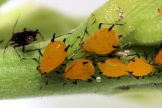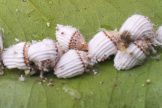
These little insects are 3-7mm long and covered in a white ‘mealy’ wax. Adults are slow moving and feed by sucking sap from the plant tissues. Females lay their eggs in a cocoon of waxy filaments, as many as 200 eggs can be laid in a lifetime and consequently their numbers can rapidly expand; particularly in temperatures around 25C (high humidity is also favourable for population growth – often seen in greenhouses).
Mealybugs suck the sap from plants and then excrete a sweet honeydew which in turn is fed on by ants. The ants will ‘farm’ the mealybugs, moving them around the plant and spreading the infestation. Honeydew is also the perfect medium for sooty mould growth, so an infestation of mealybugs is often followed by sooty mould (true for aphids and scale infestations as well).
Feeding can directly damage the plant by removing fluids and nutrients, also by the release of toxic salivary compounds in to the plant tissues. They can also transmit viruses from one plant to the next. Mealybugs are relatively easy to control using biological control agents (parasitic wasps and mites) or by using low toxicity pesticides. So even though a bad infestation looks terrible, don’t panic, you can without too much difficulty rescue that favourite orchid, daphne or leptospermum.





